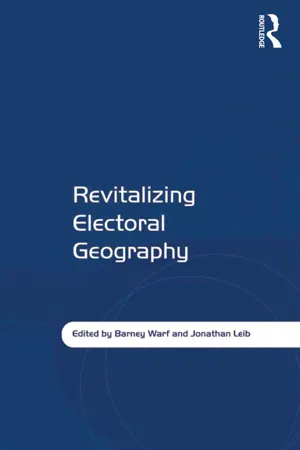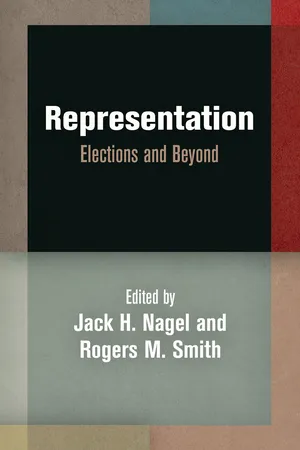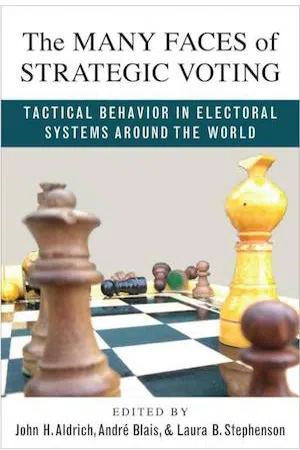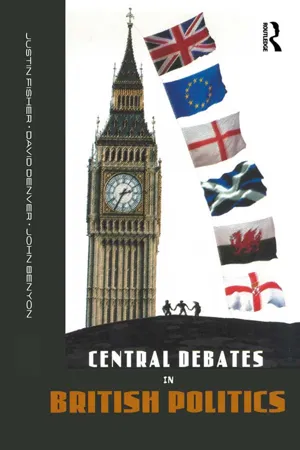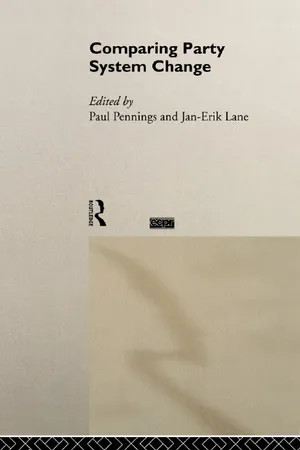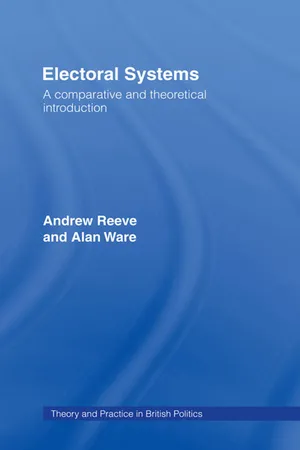Politics & International Relations
First-Past-The-Post Voting
First-Past-The-Post (FPTP) voting is a simple plurality voting system where the candidate with the most votes wins, regardless of whether they have a majority. It is commonly used in single-member district elections and tends to favor larger political parties. Critics argue that FPTP can lead to disproportionate representation and may not accurately reflect the overall preferences of the electorate.
Written by Perlego with AI-assistance
Related key terms
7 Key excerpts on "First-Past-The-Post Voting"
- eBook - ePub
- Jonathan Leib, Barney Warf(Authors)
- 2016(Publication Date)
- Routledge(Publisher)
Single-member constituency systems are a minority in the world, being especially popular only in the English-speaking countries, most of them formerly part of the British Empire. Among those countries there have been moves away from that arrangement: in 1994, for example, South Africa’s first fully democratic general election – and all subsequent contests – have been held using a proportional representation (PR) list system and two years later New Zealand’s general election for the first time used a hybrid system, introduced after two popular referendums rejected the British system that had previously been used there (Renwick, 2010).First-Past-The-Post (FPTP) – or Plurality – Elections
FPTP elections have been the sole means of electing members of the House of Commons only since 1951. In the nineteenth century multi-member constituencies were the norm, with electors having the same number of votes as there were seats to be filled, so that if there were two seats for a constituency the two candidates with the largest number of votes were elected. The Reform Acts of that century (1832, 1867, 1885) and of 1918 slowly replaced those seats with single-member constituencies, but it was not until 1949 that the last multi-member constituencies were removed (Rossiter et al., 1999).FPTP elections are often promoted as straightforward, especially for the elector; the act of voting is ostensibly simple – voters choose their preferred candidate/party – and identification of the winner is similarly clear – the candidate with most votes. But the system is open to many distortions and biases, and can – in most circumstances – present the voters with difficult choices.The results of UK general elections since 1950 have been characterized by two main features. The first is disproportionality: parties’ percentages of the votes cast are not commensurate with their percentages of the legislative seats won. Some get a higher percentage of seats than votes; others get the reverse. In general, the largest party in terms of votes cast gets an even larger share of the seats and the smallest parties get lower shares of the seats than of the votes – there is in effect a ‘winner’s bonus’, which usually means that the winning party gets a majority of seats in the House of Commons (even though no party has won a majority of votes at any election during that entire period). But this is not always the case. In 1951, for example, Labour won 48.8 percent of the votes cast (its largest share ever) and the Conservative-Unionists 48.0 percent, but the latter got 321 seats (a Parliamentary majority) to Labour’s 295. At the first election held in 1974, the situation was reversed: the Conservatives won 37.9 percent of the votes compared to Labour’s 37.2, but Labour got four more seats than its main opponent (but not a Parliamentary majority). And then in 2010, the Conservatives were again the largest party, with 37.4 percent of the votes, but they obtained only 47.2 percent of the seats, resulting for the first time since 1945 in the creation of a formal coalition government. - eBook - ePub
Representation
Elections and Beyond
- Jack H. Nagel, Rogers M. Smith(Authors)
- 2013(Publication Date)
- University of Pennsylvania Press(Publisher)
I start with the electoral system. Almost all elections in the U.S. are held under first past the post (FPTP), under which the candidate with the most votes is elected in single-member constituencies. The dominant pattern in contemporary democracies is to have proportional representation (PR) or a mixed system with some dose of proportionality. First-past-the-post elections are not exceptional. They prevail in Canada, the Caribbean Islands, India, and the UK, basically in former British colonies. But they do not exist outside former British colonies, and quite a few of these colonies have abandoned them: Ireland for the single transferable vote (STV), Australia for the alternative vote (AV), and New Zealand for a mixed-member-proportional (MMP) system. Even in the UK, FPTP is now used only for national legislative elections. Furthermore, none of the new democracies have adopted it.Most experts believe that FPTP is not a very good system. Bowler, Farrell, and Pettitt (2005) asked international experts to rank-order nine electoral systems. First past the post came out six out of nine in mean rank, far behind MMP, STV, open-list PR, AV, and even closed-list PR. Expert international opinion is that there should be some dose of proportionality. I should add that expert support for PR has weakened recently, especially among economists who have argued that coalition governments produced by PR systems foster logrolling (see Persson and Tabellini 2003; Bawn and Rosenbluth 2006). The new trend is to argue that the “best” system is one with a weak dose of proportionality, that is, low magnitude district PR (see, most especially, Carey and Hix 2011). Still, the majority view among experts is that first past the post is not a “good” system.American presidential elections are not held under first past the post. The voting rule is majority, that is, a candidate must obtain more than half of the votes within the Electoral College (though electors are chosen by plurality rule within states). The U.S. is, on this score, unique. No other contemporary nonparliamentary democracy elects its president indirectly (Shugart 2000). The few electoral colleges that existed, such as in Argentina and Taiwan, have been abolished. As Shugart (150) notes, “as long as the representatives who make the selection are themselves democratically elected and accountable through subsequent election, indirect election arguably is no less democratic than direct election, and it may be especially consistent with principles of federalism.” Yet the point is that electoral colleges are almost unanimously viewed as “dépassé” and unacceptable in a democracy. - eBook - ePub
Government Failure
A Primer in Public Choice
- Gordon Tullock, Gordon L. Brady, Arthur Seldon(Authors)
- 2002(Publication Date)
- Cato Institute(Publisher)
3 Under this system, the population is divided geographically into single constituencies. Usually the constituencies have about the same number of voters in each of them. Sometimes, however, this is not true: the U.S. Senate is an obvious example. The people who hold the seats in these constituencies are mostly elected by one of two systems. The first, used in Britain and most of its former colonies, is “first-past-the-post.” Under this system, a large number of candidates may be nominated for a given office and the one with the largest number of votes is declared elected regardless of how few those votes may be. In present-day Britain, for example, the party in power normally receives less than the majority of the votes because three major parties run candidates. Salvador Allende in Chile became president with only 36 percent of the vote because his two opponents split the remainder of the vote almost evenly between them. It is sometimes said that first-past-the-post leads to a government with strong parties because splinter parties have almost no chance of putting anyone in the legislature. Although there is a strong drive in first-past-the-post systems to form large coalitions in order to win, this drive is not overwhelming and sometimes may fail.With proportional representation, Britain would normally have a coalition government, usually composed of the Liberals and one other party, because coalition of the Labour Party and the Conservative Party would be unlikely. The prime minister would likely be Liberal. Exactly how large the Liberal vote would be is hard to say because the current polls are based on the opinions of people who are accustomed to the present method and have not thought about how they would operate under the other system. That proportional representation would greatly change the outcome is fairly obvious.The Variety of Voting Rules
Many different voting rules are used in the world and each leads to a somewhat different outcome. Saari has produced a rigorous mathematical proof that for a given set of voters with unchanged preferences, any outcome can be obtained by at least one voting method.4 - eBook - ePub
- John Aldrich, Laura B. Stevenson, André Blais(Authors)
- 2018(Publication Date)
- University of Michigan Press(Publisher)
While some observers claim that strategic voting is associated with FPTP but not with PR voting procedures, the Gibbard-Satterthwaite theorem tells us that logically there are opportunities for strategic voting in every system, including PR. What makes FPTP special in this sense is that the logic of wasted voting is very easy to see and implement. Indeed, parties and candidates often pursue campaign strategies that remind voters about this logic and instruct them on what to do. The situation is more complex with PR voting. Empirically, the evidence seeming to support “wasted” voting may well be as clear and compelling under PR as under FPTP (see Abramson et al. 2010; Riera 2016, table 1.1). Table 1.2 offers a simple example, the 1999 Israeli election. In that election, Israelis cast two votes, one for prime minister under pure FPTP rules and one for representation in the Knesset under what are among the purest cases of PR rules in use. Nearly everyone who preferred Barak or Netanyahu most intended to vote for him. Many Mordechai supporters also intended to vote for him, but one in four reported an intention to cast a strategic vote for their second-choice candidate. That is the kind of evidence we would expect given the circumstances of the campaign at the time of the survey and assuming that voters are purely investment-oriented. But Israelis also cast a vote for the Knesset under highly proportional rules. Table 1.2B shows that, if anything, the results are even stronger in support of the “wasted voting” account in the Knesset election.At least three kinds of outcomes under PR might motivate strategic voting. First, voters might support a party to ensure that it achieves representation in the parliament. Generally, that means that a party must pass a voting threshold—that is, receive at least a legally specified minimum proportion of the vote—to obtain any representation. Israel previously had a relatively low 2% threshold; 5%, as in Germany, is more typical; Sweden’s threshold is 4%, while Turkey’s is 10%. An extreme example of threshold politics is presented by the United States and its presidential primary system. In 2016, for example, thresholds were often as high as 15%; in other years, they have reached 20%. The higher the threshold, the harder it is for small and new parties to achieve representation (or in the US primary case, for presidential candidates to win delegates). Indeed, a threshold of 50% means that the PR system has become identical to a majority voting system. Theoretically, the set of outcomes over which a PR voter has preferences is rather like that of FPTP. There are two outcomes—the party does or does not achieve the threshold—and the citizen evaluates by preferences and expectations accordingly. While breaking the threshold is often a stated goal of a party and often claimed to motivate voters, if the party is anywhere close to the threshold in popular support, it is very difficult to measure reliably such a rare circumstance with very low percentages of support for a party just at the threshold in a survey. This consideration may be very important, but it also can only be investigated via a special research design (see Freden 2016). - eBook - ePub
- John Benyon, David Denver, Justin Fisher(Authors)
- 2014(Publication Date)
- Routledge(Publisher)
Other democratic arguments in favour of electoral reform are based on the specific advantages of particular systems and are more difficult to measure. Any system with a list element, for example, is likely to benefit the representation of women and ethnic minorities, as parties can use strategies to ensure that such candidates can be represented on the list. But this advantage is difficult to quantify and in any case, Phillips (1998) has shown that it is extremely difficult to argue for the democratic benefits of social representation in the legislature on normative grounds. Preferential systems, such as the Alternative Vote and the Single Transferable Vote, allow voters to give expression to multiple preferences which may reveal important underlying trends in popular opinion (Dunleavy and Margetts, 1994). They clearly deliver more choice than FPTP, as voters effectively have more than one vote to cast. Mixed-member systems, such as the Additional Member System, allow voters to retain a constituency link while still increasing proportionality. AMS also delivers greater choice than FPTP, because voters choose at both the constituency level and the top-up level. List PR systems, alternatively, where voters vote for party lists and are unable to choose between candidates (‘closed-list’ systems) clearly deliver least choice of all, although there are variants where voters can nominate their preferred candidates (‘open-list’ systems).The extent to which electoral systems deliver stable government, and therefore satisfies the Democratic Audit’s criteria in ensuring that ‘the composition of Parliament and the programme of government reflect the choices actually made by the electorate’, is perhaps the most difficult of all to quantify. FPTP does tend to deliver single-party government due to its ‘leaders’ bias’ effect that favours large parties. Governments elected under FPTP have a party mandate which offers a mechanism for linking electoral preferences to government action through the central party role in both; such mandates are less clear for coalition governments. However, opponents of proportional representation have argued that both coalition governments have been inherently unstable (citing Italy) and too stable (citing Germany): ‘the fact is that there are many different kinds of coalition in Western Europe alone’ (Dunleavy et al., 1998: 20). Furthermore, research has shown that coalitions can still allow parties to keep their commitments owing to agreements among the partners which let each pursue their own differing priorities (see budge, 1998). - eBook - ePub
- Jan-Erik Lane, Paul Pennings(Authors)
- 2003(Publication Date)
- Routledge(Publisher)
Were a third party such as the Liberal Democrats to get over 30 percent of the vote, its support would necessarily be enough in certain localities to pick up parliamentary seats very rapidly. This is a very high level to attain before gaining influence, however. In effect, first-past-the-post operates to consolidate and stabilize the existing party system and thus resists and deflects major movements for change. When these become very strong, however, it may register this change very rapidly.The same considerations apply to regionally strong parties like the Welsh and Scottish Nationalists. As these can generate concentrated regional support they do not suffer from under-representation to the same extent as do the Liberals. The Scottish Nationalists are still under-represented in Scotland, however, to the benefit of Labour. Were they to expand their 22 percent of the Scottish vote by another 10–15 percent, they would suddenly gain seats. The political impact of this would be an immediate demand for independence.The inflexibility of first-past-the-post thus enables the two main parties to ignore many political movements and the demands they voice. Where these become even more widely supported, perhaps because of the frustration generated by this stalemate, the electoral system creates a critical situation by suddenly registering the strength of the movement. This may happen regionally as well as nationally and where it coincides with autonomist movements may have explosive effects. Territorial or constitutional change in Britain is thus liable to come all at once, after long inattention and non-response by policy-makers.Both in its direct and indirect effects so far, however, the British electoral system has operated to reduce the number of parties by restricting effective parliamentary representation to two. It has tended to give an unequivocal parliamentary majority to only one of these two, thus promoting the creation of strong single-party majority government in the teeth of what is effectively a three-party system at electoral level. - eBook - ePub
- Andrew Reeve, Alan Ware(Authors)
- 2013(Publication Date)
- Routledge(Publisher)
8 There are two kinds of simple majoritarian systems: the Alternative Ballot (used, for example, in Australian Parliamentary elections) and the Second Ballot (which is used in French presidential elections). Both provide that there is a 'final contest' between only two candidates (or parties) so that the winning candidate must have received over half the vote. These systems have never been employed in British Parliamentary elections.Plurality
In this system the candidate or party with the largest number of votes wins, even if the proportion of the total vote taken by the winning candidate is small. In some primary elections for the US Congress winning candidates have sometimes secured less than 20 per cent of the vote, but the party system in Britain normally ensures that the winner would have received at least a third of the total vote. Only in rural Wales and Scotland, where there have been close contests involving Conservative, Labour, Liberal and Nationalist candidates, does the vote of a winning candidate today ever dip below the 30 per cent level.Proportionality
Proportional systems attempt to provide for a 'fit' between the votes cast and the share of the seats (in a Parliament) accorded to each party. Some proportional systems provide for a greater fit between votes and seats than others, and in some cases the fit is actually worse than in some nonproportional systems. For British Parliamentary elections the STV system is the proportional system most canvassed by reformers, and it is the only form of proportional representation ever to have been used in British elections - for some of the university seats between 1918 and 1945. Indeed, it could be argued that STV is almost 'as British' as plurality voting: of the countries listed by Urwin (1987b), the only two to use STV are ex-British colonies.It is important to recognize that these different electoral formulae rely on utilizing different information about a voter's preferences. A plurality system is concerned exclusively with a voter's first preference and not his or her lower-order preferences. In the first instance, a majority system makes use only of first-order preferences but second (and subsequently yet lower-order) preferences may have to be counted to produce a winner. Proportional systems are more varied. It is possible to devise a proportional electoral formula which relies solely on first preferences - for example, a single national party list system could take this form. However, many of the proportional systems which are actually used depend on the availability of voters' lower-order preferences - they could not produce proportionality without them. Moreover, proponents of proportionality are often attracted to electoral systems which use it because, in practice, they usually do involve weight being given to lower-order preferences when translating votes into seats. For example, while those advocating the introduction of STV in Britain primarily stress the alleged unfairness in the distribution of seats produced by the plurality system, some of them also assert that PR has the merit of allowing voters for the candidates of one party to express a preference between candidates of other parties.
Learn about this page
Index pages curate the most relevant extracts from our library of academic textbooks. They’ve been created using an in-house natural language model (NLM), each adding context and meaning to key research topics.
